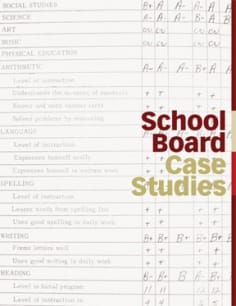 We’ve often questioned whether the local school board remains the best governance model for public education. We’re not sure whether the Chamber of Commerce’s Institute for a Competitive Workforce (ICW) shares such fundamental concerns, but it is certainly interested in improving the school boards we’ve got. Its new report profiles a baker’s dozen highly variable district boards, drawing from these case studies characteristics of successful school boards—and of the other kind. Top-notch boards (determined by whether they are linked to improved student achievement) have: limited and clearly defined responsibilities (limited to core, high-level, and strategic goals); stability (essential for reform, but not an end in itself); effective board training (which can help overcome dysfunction); and positive relationships with superintendents (with both parties proactively communicating). Struggling boards (those marred by infighting, financial issues, and low student achievement) also share some common traits: They are often voted in during “off cycle” elections (with limited voter turnout dominated by interest groups), are highly politicized, and have large (and diverse) constituencies. One treatment for ailing school boards, according to the ICW, is (not surprisingly!) strong business-leader engagement. Take Austin, for example. That city’s Chamber of Commerce, through task forces and published reports, pushed an otherwise complacent AISD board into urgent action. And in Atlanta, the business and civic communities have convened the board of their education PAC (EduPAC Atlanta) each election year to endorse and support their chosen candidates. This ICW report offers an interesting read—and some smart recommendations for districts looking to improve their board dynamics and efficacy. Still, we remain unconvinced that local school boards are the best way to govern our schools in the twenty-first century.
We’ve often questioned whether the local school board remains the best governance model for public education. We’re not sure whether the Chamber of Commerce’s Institute for a Competitive Workforce (ICW) shares such fundamental concerns, but it is certainly interested in improving the school boards we’ve got. Its new report profiles a baker’s dozen highly variable district boards, drawing from these case studies characteristics of successful school boards—and of the other kind. Top-notch boards (determined by whether they are linked to improved student achievement) have: limited and clearly defined responsibilities (limited to core, high-level, and strategic goals); stability (essential for reform, but not an end in itself); effective board training (which can help overcome dysfunction); and positive relationships with superintendents (with both parties proactively communicating). Struggling boards (those marred by infighting, financial issues, and low student achievement) also share some common traits: They are often voted in during “off cycle” elections (with limited voter turnout dominated by interest groups), are highly politicized, and have large (and diverse) constituencies. One treatment for ailing school boards, according to the ICW, is (not surprisingly!) strong business-leader engagement. Take Austin, for example. That city’s Chamber of Commerce, through task forces and published reports, pushed an otherwise complacent AISD board into urgent action. And in Atlanta, the business and civic communities have convened the board of their education PAC (EduPAC Atlanta) each election year to endorse and support their chosen candidates. This ICW report offers an interesting read—and some smart recommendations for districts looking to improve their board dynamics and efficacy. Still, we remain unconvinced that local school boards are the best way to govern our schools in the twenty-first century.
Institute for a Competitive Workforce, School Board Case Studies (Washington, DC: U.S. Chamber of Commerce, May 2012).
